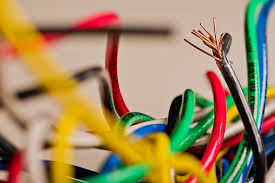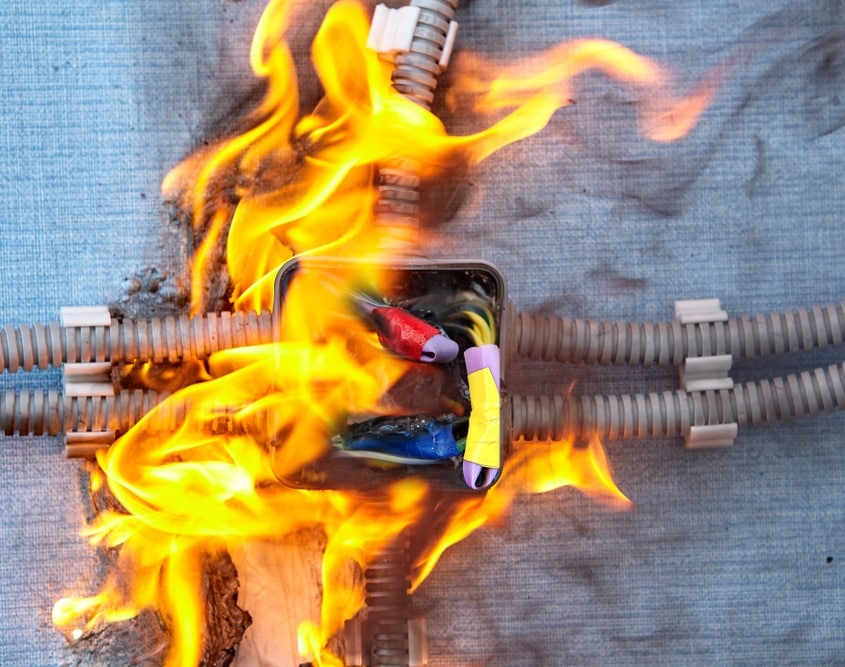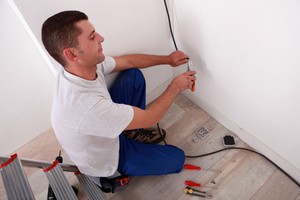The Electric Wiring of Buildings
THERE are many practical hints in this little book which appeal to common sense, although from the point of view of the ordinary electric wireman they are quite unorthodox. The author points out, for example, that the wiring of many houses is spoilt by placing the wall sockets indiscriminately without regard to the position or character of the apparatus to be connected to them. It is as absurd to place the wall socket for a floor standard lamp or vacuum cleaner three feet from the floor as to put one for a table standard at floor level, if the table is to be against the wall. It is quite right to put the wall socket for an electric fire on the skirting, but the almost universal practice of placing the switch there as well is foolish. It is true that this saves the cost of a wood block and a few feet of wire, but this saving of a shilling or two on capital cost is only effected by compelling people for ever afterwards to stoop down to the floor when they want to switch on or off the electric fire. The book finishes up with a useful chapter on bells, telephones, fire alarms, and radio. As a rule, it is advisable to have all these kinds of wiring done before the building is actually furnished. In the case of telephones, however, it is sometimes difficult to tell which is the most suitable place for them before the house is furnished, and hence surface wiring is very frequently used for telephone work. The proper wiring of all electric radio receiving sets deserves special care. Unless the Institution of Electrical Engineers Wiring Regulations, published in June 1928, be followed, there may be danger from shock or fire.

Electrical Safety Tips
Before you tackle any electrical task, review these top safety concerns.
When installing or using your electrical system, there is always the chance of shock. Now there will be some DIYers who are comfortable with basic wiring practices; however, unless you’re absolutely qualified for system installation, DIY recommends you leave the installation of your home’s electrical system to licensed electricians.
Not only will a licensed electrician make sure your electrical system meets with all required safety codes, they can also oversee the installation of common safety products. For example, one of the most common items added to your electrical system is a ground fault circuit interruptor — or GFCIs for short.
By installing a ground fault circuit interruptor — or ground fault circuit breakers — you can protect areas that may be moist, such as bathrooms and kitchens. A ground fault interruptor is an electrical device designed to protect you from serious injury due to shock.
GFCIs constantly monitor the electricity flowing in a circuit. Should that current be interrupted for any reason — or waver by even the slightest amount — the GFCI will instantly shut down the current flowing through that circuit.
Note: A GFCI will respond to a current variation too small for even a circuit breaker or fuse to detect.
Along with GFCIs there are a number of simple precautions you can take at home that will prevent injuries related to your home’s electrical systems. Here’s a rundown:
- Always remove cords from a socket by grabbing the plug. Never tug on an appliance cord. Removing cords in this fashion can lead to fraying, and frayed cords can cause electrical shock.
- Frayed cords that are under or on carpet can cause a fire and should be replaced or repaired.
- Always use the recommended wattage bulb in lamps and light fixtures.
- Avoid using electrical appliances in wet places. If you must work in a wet or damp area, always use a portable GFCI outlet for the needed appliance.
- Never overload an outlet.

Make Your Home Safer with an Electrical Wiring Upgrade
Electrical wiring can be hazardous in your home if it is outdated or damaged. Faulty wiring and overload power strips can cause an electrical fire. And if you have unprotected electrical outlets, it can burn or shock you if you accidentally touch it. With these in mind, here are some reasons why you should do an upgrade now and tips on how to properly do it.
- Electrical Wiring Hazards to Look For
The first step in doing an electrical wiring upgrade in Singapore is to inspect your home and check your existing wiring connections to immediately identify if they pose serious threats to your home and your family.
The most common electrical problems include outdated wiring, electrical appliances left plugged in near water sources, wrong wattage light bulbs, overload power outlets, damaged extension cords, improperly used circuit breakers, and poor electrical installation.
- DIY or Seek Professional Help?
Don’t fall into the trap of believing you can save less if you’ll do the upgrade on your own. While there are electric works that you can do yourself, upgrading and updating your electrical wiring in Singapore is certainly not one of those. This kind of job isn’t appropriate for DIY as it is best left to the experts. Remember that only one mistake can easily turn into a disaster and damage your home which can cost you more in the long run.
If you’re living in an old home, it’s strongly recommended finding an electrician who has vast experience working on such homes. The procedure is quite complicated and it requires technical knowledge and understanding especially if your home is30 years or older.
Aside from your home’s age, other signs that you need to call an electrician immediately sparking electrical wires and cables, flickering light fixtures, fuses blowing repeatedly, dimming of lights, burning smell from an appliance, and obsolete electrical panels.
Moreover, when you work with an expert and seek his electrical services, you can have peace of mind knowing that he exactly knows what he’s doing.
- Prepare Your Budget
An electrical wiring upgrade can be expensive, but money should not be an issue when it’s necessary for the safety and convenience of your home. It just actually depends on your choice of electrician; so, it’s worth doing your research to find a company or someone from whom you can get the most out of your money.
Hiring one that offers the cheapest upgrade and installation service without considering their experience and skills will only put you at risk. Don’t settle for cheap just to save money. Instead, you should be hiring one with proper qualifications and a proven track record of success and recommendations. And when going through the candidates you have chosen, make sure to break them down into categories to make a well-informed decision.
- Let the Experts do the Upgrade
If you still think that you can afford to upgrade your electrical wiring in Singapore on your own, pushed that thought away. When it comes to dealing with wiring works, always call in the experts.

Different Types of Electrical Wirings
When you want to change the wiring of your home, you will have the choice of selecting from several kinds of wirings available in Singapore.
Even if you hire a professional to do the wiring/rewiring, you can still give your opinion about the kind of wiring you want. The different kinds of electrical wiring which are available in the market are listed below:
- Non-Metallic Cables (NM Cables)
NM cables are the most common types of wires which are used in houses and residential buildings in Singapore. They contain three types of wires distinguished by different colors.
A red or brown wire inside the cable signifies a live wire that carries the current. A black or blue wire is the neutral wire and a green or yellow one signifies the ground wire. These types of cables are usually suited for dry spaces such as rooms of houses or offices.
- Underground Feeder (UF)
Underground feeder can be considered a subclass of NM cables with the difference being that in UF cables, each of the three wires are covered individually by a solid plastic sheathing.
The three wires are the same as NM cables namely a live wire, a ground wire, and a neutral wire. All these three wires are covered separately as opposed to the NM cables where they are enclosed together. UF cables are mostly used for wet and damp areas such as the kitchen, bathroom, or other exposed areas.
- Conduits
Conduits are the types of wires which are mostly used in houses but not as part of the inner wiring of the house. These wires and cables are visible on the walls and ceilings of the rooms. In these cables, the electric wires are encased in a plastic or metallic tube.
They are insulated by a layer of nylon which gives them the thermoplasticity that makes them highly heat resistant. Because of their good insulation, they can be used in dry as well as wet places.
- Low Voltage Wires
Low voltage wires basically comprise two set of wires that are used for those sockets and circuits which are of low voltage. They are enclosed in a plastic casing and contain only two wires as opposed to NM cables that have three wires.
- Aluminum Coated Lead Wires
For more high-power and intricate needs, aluminum coated lead wires are used. Lead is a heavy metal which does not get easily affected by corrosion or humid conditions. It is coated with an alloy of lead and aluminum making it extra durable and strong. It does not get damaged from extreme weather conditions or other wear and tear like other types of electrical cables.
HOW TO TELL IF YOUR HOUSE NEEDS WIRING REPAIR
Wiring Repairs in New HavenThe electrical wiring in your home is normally present in every room in the house. 1972 and prior built homes contained wiring which didn’t last as long because it was more susceptible to shorting and wear.
The insulation and other materials are likely degraded if your home is this old and hasn’t had a complete rewiring. Regardless of the material, the wiring will eventually need repairs, especially at any point where it connects to something such as outlets, fixtures, or switches.
When electrical wires start to get old, the first problems are usually seen at a point where it connects to something. Common problems include the expansion and contraction of the electrical wiring material over time. Eventually, the connections can become loose and will then need repair. But it’s not always easy to know when something goes wrong.
The problem with electrical wiring is that it is not easily accessible. It runs inside the walls and ceilings of your home. Power then runs through the wire and is controlled by the panel box where your circuit breakers are located. The other side of the wire runs to outlets or fixtures.
Signs Your Wiring Needs To Be Repaired
One sure sign that your outlet wiring needs repair is if you plug something in and it doesn’t fit snugly or it won’t go in all the way. This is a dangerous situation and the outlet should be repaired right away. Electricity can arc from the wiring to you, causing electrical shock. The outlet can also send a surge of power that will short out anything plugged in at the time.
If your lights are flickering when you use the microwave or sometimes won’t respond when you flip the switch, this is another sure sign the wiring is getting old and needs repair. There are times when it’s so old it has to be completely replaced throughout the house. This happens when the insulation that protects each wire deteriorates. Most of the time, there is a simple explanation for this but either way, you will want to have someone qualified to take a look at the problem.
Sometimes the problem can be with a fixture or the item you are trying to plug in. If it’s a fixture that is permanently attached to the home, you will want to have it repaired or replaced. Be sure you check the simple things first such as replacing a light bulb and checking for a tripped breaker.
One time, a lady was at home and heard a loud pop. She went outside to the air conditioner where she thought it came from and the breaker to the unit was black and smoking. Any strange noises or smells warrant a call to an electrician. It is not worth having a house fire due to dangerous wiring. The lady had an electrician check the damage so she found out that the entire circuit had been fried by ants crawling around in the outside A/C breaker box.